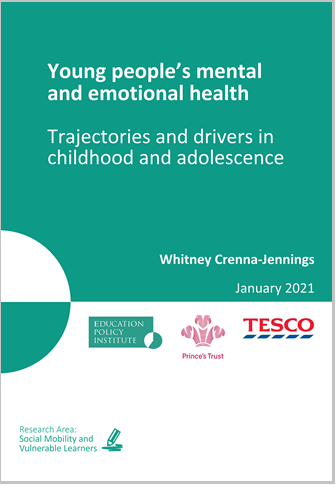The Education Policy Institute (EPI) and The Prince’s Trust have published a major study on the mental health and wellbeing of young people in Generation Z.
Based on data from the Millennium Cohort Study, and supported by Tesco, the report reveals new insights into the determinants of young people’s wellbeing, including how it is affected by their relationships, background, and use of social media.
The study examines the personal experiences of young people in England, at age 11, 14 and 17. This is supplemented by focus group responses from November 2020.
The research shows that while the wellbeing of all young people declines by the end of their teenage years, there is a strong gender divide within this: girls see far lower levels of wellbeing and self-esteem than boys – driven by a sharp fall of both during mid-adolescence.
Girls experience more depressive symptoms than boys – such as feeling worthless or hopeless – while they are also more likely to feel unhappy about their physical appearance. The proportion of girls that feel unhappy about their appearance rises considerably between age 11 and 14, from 1 in 7 to around 1 in 3.
Social media also plays a key role for the generation of “digital natives”, with the new findings showing that very frequent use has an adverse effect on the wellbeing of boys and girls, along with the self-esteem of girls.
Based on the new findings, researchers determine that the experience of the pandemic is likely to continue to exacerbate existing mental health and wellbeing problems among young people. National estimates show that 1 in 6 young people now have a probable mental illness – up from 1 in 9.
While school closures were necessary in order to ensure the safety of pupils, with positive mental health outcomes closely linked to relationships and social experiences in the school environment, researchers fear that the increased isolation seen over the last year risks causing long-term damage to the wellbeing of hundreds of thousands of young people.
You can download the full report here.
Key findings
How does the mental health and wellbeing of Generation Z change through their teenage years, and how does it differ by gender?
Clear differences emerge with boys’ and girls’ mental health and wellbeing, and this is also affected by the stage of adolescence that they are in.
- The wellbeing and self-esteem of all young people drops as they move into secondary school and continues to fall as they grow older, but girls see a far greater decline than boys.
- Girls see a significant drop in their wellbeing at age 14 and once again at age 17. Their self-esteem also drops sharply at age 14, before stabilising at age 17.
- Depressive symptoms rise among both boys and girls between the ages of 14 and 17 but they increase more markedly for girls.
- While the majority of young people remain happy with their lives as they enter secondary school, the proportion of girls who are unhappy rises.
- This fall in happiness is particularly stark in relation to their personal appearance: between the ages of 11 and 14, the proportion of girls that feel unhappy about their appearance almost doubles from around 1 in 7 (15%) to around one in three (29%).
Which factors have an impact on the mental health and wellbeing of Generation Z?
The following factors had independent and statistically significant effects on young people’s mental health and wellbeing.
- There is an association between family income and young people’s mental health: those from low-income families are more likely to have lower levels of wellbeing and self-esteem, and more depressive symptoms. There is also evidence that the pandemic has exacerbated existing social inequalities, putting additional pressure on young people’s mental health.
- Heavy use of social media is shown to negatively affect girls’ wellbeing and self-esteem at ages 14 and 17, regardless of pre-existing levels. It also negatively affects boys’ wellbeing at age 14, also regardless of their previous state of mental health.
- Being bullied in childhood has strong and enduring effects on both boys’ and girls’ mental and emotional health into their teenage years. This is particularly the case for wellbeing: the more often a child was bullied in childhood, the higher their risk of low wellbeing by age 14.
- Frequent physical exercise plays a positive role in young people’s wellbeing and self-esteem and in limiting depressive symptoms especially for boys at age 14. At age 17, frequency of exercise had a positive impact on both boys and girls. Participation in activities and sports will have fallen considerably due to school closures and lockdown, likely adversely affecting mental health and wellbeing.
- Frequent arguing with parents is linked to lower wellbeing at age 17, while at age 14 it is associated with both worse wellbeing and an increase in depressive symptoms.
- Being placed in the bottom stream in primary school is associated with lower self-esteem for boys later on at age 14, supporting existing evidence of the stigmatising effect of being placed in low performance streams.
- Poor maternal health leads to lower wellbeing and self-esteem and an increase in depressive symptoms in both girls and boys at age 14. Maternal depression in infancy is associated with a rise in depressive symptoms in girls at age 17.
- Across all ages of adolescence, girls who feel unsafe in their neighbourhood are at increased risk of worse wellbeing and having more depressive symptoms.
Policy Recommendations
Based on the research evidence and in light of the risk of the pandemic leading to a further deterioration in young people’s mental health and wellbeing, EPI recommends that the government should:
- Urgently introduce a £650m funding package specifically for supporting children and young people’s wellbeing. This funding would allow schools to hire additional staff to deliver mental health support to pupils and teaching staff, run interventions to address socio-emotional skills gaps, improve links with local CAMHS, and deliver training to teachers.
- Build on existing mental health content in the Health Education and Relationships and Sex Education curriculum, to reflect existing evidence;
- Improve the capacity of school staff to support children with mental health needs;
- Develop an evidence-based policy to prevent and tackle bullying including clear plans for funding, delivery and accountability;
- Publish a plan for rollout of a four-week waiting time for specialist mental healthcare across the country including clear details on funding and staffing requirements;
- Improve young people’s access to resources and areas for physical activity;
- Increase funding to local mental health providers to allow them to better identify and support children with needs which do not meet diagnostic thresholds;
- Develop a cross-government and cross-sector strategy to reduce family poverty and ensure young people feel safe in their communities.
The Prince’s Trust will endeavour to work in partnership with government and schools to progress these recommendations, where appropriate.
This report is published in partnership with The Prince’s Trust, and is supported by Tesco.



